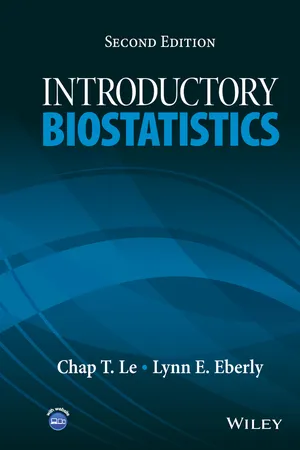
- English
- ePUB (mobile friendly)
- Available on iOS & Android
Introductory Biostatistics
About this book
Maintaining the same accessible and hands-on presentation, Introductory Biostatistics, Second Edition continues to provide an organized introduction to basic statistical concepts commonly applied in research across the health sciences. With plenty of real-world examples, the new edition provides a practical, modern approach to the statistical topics found in the biomedical and public health fields.
Beginning with an overview of descriptive statistics in the health sciences, the book delivers topical coverage of probability models, parameter estimation, and hypothesis testing. Subsequently, the book focuses on more advanced topics with coverage of regression analysis, logistic regression, methods for count data, analysis of survival data, and designs for clinical trials. This extensive update of Introductory Biostatistics, Second Edition includes:
• A new chapter on the use of higher order Analysis of Variance (ANOVA) in factorial and block designs
• A new chapter on testing and inference methods for repeatedly measured outcomes including continuous, binary, and count outcomes
• R incorporated throughout along with SAS®, allowing readers to replicate results from presented examples with either software
• Multiple additional exercises, with partial solutions available to aid comprehension of crucial concepts
• Notes on Computations sections to provide further guidance on the use of software
• A related website that hosts the large data sets presented throughout the book
Introductory Biostatistics, Second Edition is an excellent textbook for upper-undergraduate and graduate students in introductory biostatistics courses. The book is also an ideal reference for applied statisticians working in the fields of public health, nursing, dentistry, and medicine.
Frequently asked questions
- Essential is ideal for learners and professionals who enjoy exploring a wide range of subjects. Access the Essential Library with 800,000+ trusted titles and best-sellers across business, personal growth, and the humanities. Includes unlimited reading time and Standard Read Aloud voice.
- Complete: Perfect for advanced learners and researchers needing full, unrestricted access. Unlock 1.4M+ books across hundreds of subjects, including academic and specialized titles. The Complete Plan also includes advanced features like Premium Read Aloud and Research Assistant.
Please note we cannot support devices running on iOS 13 and Android 7 or earlier. Learn more about using the app.
Information
1
DESCRIPTIVE METHODS FOR CATEGORICAL DATA
1.1 PROPORTIONS



Example 1.1
Table of contents
- COVER
- TITLE PAGE
- TABLE OF CONTENTS
- PREFACE TO THE SECOND EDITION
- PREFACE TO THE FIRST EDITION
- ABOUT THE COMPANION WEBSITE
- 1 DESCRIPTIVE METHODS FOR CATEGORICAL DATA
- 2 DESCRIPTIVE METHODS FOR CONTINUOUS DATA
- 3 PROBABILITY AND PROBABILITY MODELS
- 4 ESTIMATION OF PARAMETERS
- 5 INTRODUCTION TO STATISTICAL TESTS OF SIGNIFICANCE
- 6 COMPARISON OF POPULATION PROPORTIONS
- 7 COMPARISON OF POPULATION MEANS
- 8 ANALYSIS OF VARIANCE
- 9 REGRESSION ANALYSIS
- 10 LOGISTIC REGRESSION
- 11 METHODS FOR COUNT DATA
- 12 METHODS FOR REPEATEDLY MEASURED RESPONSES
- 13 ANALYSIS OF SURVIVAL DATA AND DATA FROM MATCHED STUDIES
- 14 STUDY DESIGNS
- REFERENCES
- APPENDICES
- ANSWERS TO SELECTED EXERCISES
- INDEX
- END USER LICENSE AGREEMENT